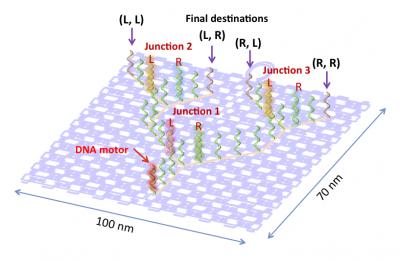DNA motor programmed to navigate a network of tracks
January 24, 2012

A depiction of a DNA origami tile with a built-in network of tracks. The DNA engine or motor, in red, can be programmed to navigate a series of junctions to reach one of four desired end points (credit: Sugiyama Lab, Kyoto University iCeMS)
Researchers at Kyoto University and the University of Oxford have used DNA building blocks to construct a motor capable of navigating a programmable network of tracks with multiple switches, allowing motor molecules to travel along these rail systems.
The research uses DNA origami — strands of DNA molecules sequenced to self-assemble into 2D or 3D structures.
“We have demonstrated that it is possible to build nanoscale devices that function autonomously, and cause such devices to produce predictable outputs based on different, controllable starting conditions,” explained Dr. Masayuki Endo of Kyoto University’s Institute for Integrated Cell-Material Sciences (iCeMS).
The team expects that the work may lead to the development of even more complex systems, such as programmable molecular assembly lines and sophisticated sensors.
Ref.: Shelley F. J. Wickham, et al., A DNA-based molecular motor that can navigate a network of tracks, Nature Nanotechnology, 2012; [DOI:10.1038/nnano.2011.253]